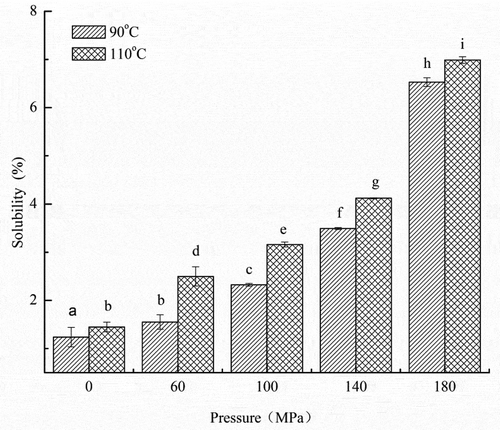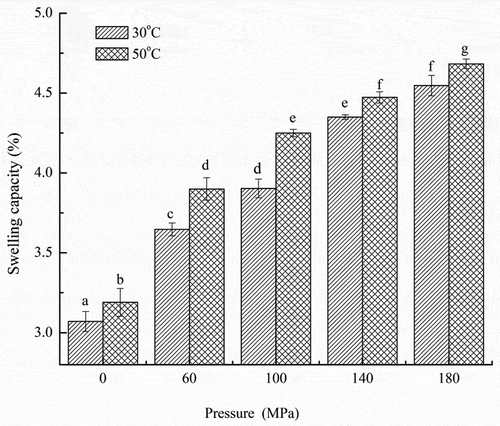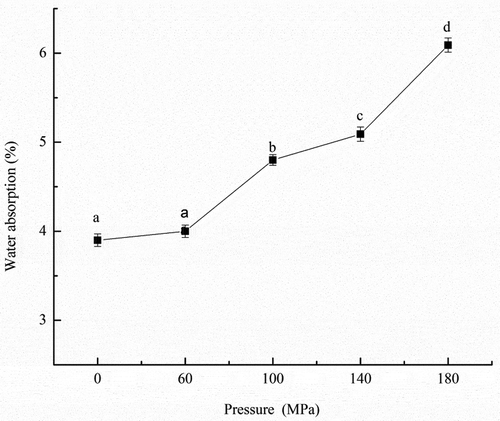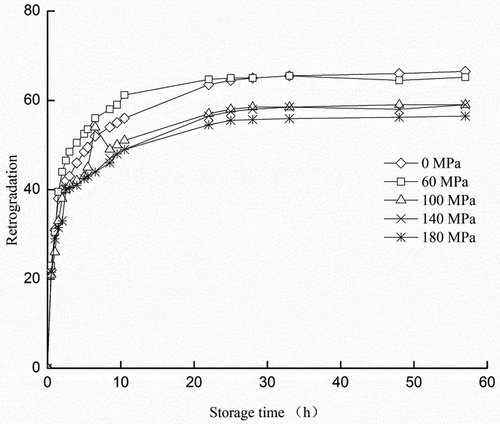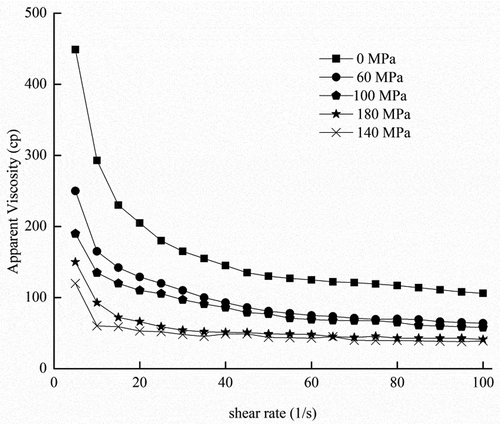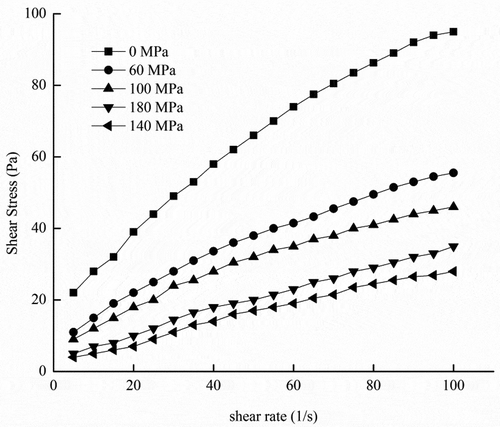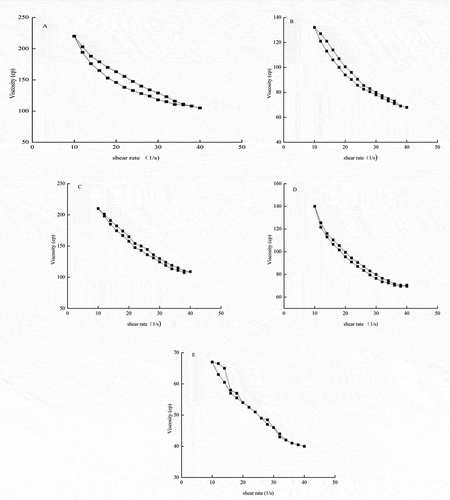ABSTRACT
The effect of dynamic high-pressure microfluidization on physicochemical and rheological properties of rice amylose pastes were examined. The amylose dispersions were pressurized at 60, 100, 140, and 180 MPa. The microfluidization treated rice amylose showed elevated solubility, swelling power, and moisture absorbability. The retrogradability was significantly decreased with the pressure increase. Iodine blue value showed a significant increase at 60~140 MPa, while a slight decrease at 180 MPa. The rheological results indicated that native amylose was a non-Newtonian fluid and displayed pseudoplastic fluids characteristics. The amylose moved toward a Newtonian fluid behavior and its rheopexy decreased with the pressure increased.
Introduction
Starch is an abundant and widespread polymer that is present in various plant tissues.[Citation1] Starches have been used in different industries, such as the paper, textile, and food industries, due to their physicochemical properties.[Citation2] The physicochemical properties of starch are determined by its source and the molecular structures of amylopectin and amylose, which are two major components of starch granules. Rice is one of the most important crops in the world and an important source of starch. However, the application of native rice starch granule is limited by its low solubility, low swelling power, low heat resistance, and uncontrolled paste consistency.[Citation3,Citation4]
Starch is commonly modified by physical, chemical, or enzymatic methods to obtain the desired physicochemical properties. Given the concern for health issues, physical modification methods are preferred in the food industry. High-pressure technologies, such as high-hydrostatic pressure (HHP) treatment, have been applied in the preparation of modified starch.[Citation5] The alteration of the morphological characteristics and crystalline structure of starch by HHP has been reported.[Citation6] Yun et al.[Citation7] indicated that appropriate HHP processing could significantly improve the functionality of rice starch. Hu et al.[Citation8] suggested that the retrogradation rate of rice starch gelatinized by HHP is slower than that of starch gelatinized by heat.
Dynamic high-pressure microfluidization (DHPM) is an innovative high-pressure technology that is different from HHP. Combined strong forces are exerted on starch during DHPM treatment, including high-velocity impact, high-frequency vibration, instantaneous pressure drop, intense shear, and cavitation.[Citation9] In addition, DHPM can achieve ultra-high pressure (up to 200 MPa) and continuous operation. This treatment has been considered as a promising method in improving many food constituents,[Citation10,Citation11] for example, improving the physicochemical properties of whey protein.[Citation12]
In this study, we investigated the effects of DHPM treatment on the physicochemical properties of rice amylose. Rice amylose was isolated and subjected to DHPM at pressures ranging from 60 to 180 MPa. The physicochemical properties, including the solubility, swelling power, moisture absorbability, iodine blue value, retrogradability, and rheological characteristics, were evaluated before and after DHPM treatment.
Materials and methods
Materials and reagents
Commercial rice starch was purchased from Dacheng Industrial Group Co. (Changchun, China). All of the chemicals (analytical grade) were purchased from Da Mao Reagent Co. (Tianjin, China).
Isolation and purification of rice amylose
Rice amylose was isolated and purified using the method of Takeda et al.[Citation13] with minor modifications. Rice starch (10 g) were filtrated with a small amount of anhydrous ethanol and dissolved in 250 mL of 0.5 mol·L−1 NaOH. The suspension was placed in a boiling water bath and incubated for 30 min. After the starch solution was cooled, the undissolved substances were removed by centrifugation (Shanghai Anting Science and Technology Instrument Company, China) at 3000 rpm for 20 min. The pH of supernatant was then adjusted to neutral with 2 mol·L−1 of HCl before addition of 200 mL of butanol–isopentanol (v/v, 3:1) into the mixture. The mixture was incubated in boiling water for 25 min and centrifuged at 3000 rpm for 20 min. The precipitate was then used as crude rice amylose. Subsequently, the crude rice amylose was dissolved in 120 mL of an n-butyl alcohol aqueous solution (the volume ratio of n-butyl alcohol and water was 1:9). The mixture was stirred in a boiling water bath until the dispersed solution was transparent. The mixture was then cooled in a refrigerator at 2–4°C for 24 h. The precipitate was obtained by centrifugation at 3000 rpm for 20 min. The above procedure was performed three times, and then the precipitate was filtrated with pure ethyl alcohol six times. The purified rice amylose was obtained after lyophilization. The extracted rice amylose content was estimated by iodine colorimetry based on the method of Hoover and Ratnaykae.[Citation14] The amylose content of the extracted starch sample was about 85%.
DHPM treatment of rice amylose
A rice amylose suspension (6%, w/v) was prepared in deionized water at 25°C with stirring. The mixture was treated with a micro jet homogenizer (M-700; Microfluidics Company, USA) at 60, 100, 140, and 180 MPa, respectively. After which, 500 mL of each DHPM-treated rice amylose suspension was collected, then these samples were lyophilized (ALPHA 1-2; Martin Christ Company, Germany).
Solubility and swelling power
The solubility and swelling power of DHPM-treated and untreated amylose were determined using the method of Choi et al.[Citation3] with minor modifications. The 2% (w/v) amylose suspension 250 mL was divided into five aliquots. Four parts were separately heated at 30, 50, 90, and 110°C in an oil bath for 30 min with continuous stirring at 75 rpm. The gelatinized samples were cooled to room temperature and centrifuged at 4800 rpm for 20 min. The resulting supernatant was further dried at 100°C and then weighed repeatedly until a constant weight was achieved. The solubility (90 and 110°C) and swelling power (30 and 50°C) were calculated by using the following formulas:
where W is the weight of dry amylose (g), A is the weight of the soluble amylose (g), and P is the weight of precipitate in centrifugal tube (g).
Moisture absorption
The moisture absorbability of DHPM-treated and untreated amylose was investigated using the method of He et al.[Citation15] with minor modifications. The samples (0.5 g) were accurately weighed and transferred into an incubator (Beijing Hualeda Science and Technology, Ltd., China). After incubation at 25°C for 50 h, the samples were weighed again. The tests were performed in triplicate, and the moisture absorbability (Ma) was calculated as follows:
where W0 and W are the dry-weight values of amylose before and after incubation, respectively.
Iodine blue value
The blue value was measured as described by Shi et al.[Citation16] with some modifications. Rice amylose (0.1 mg) was dissolved in 1 mL iodine reagent (contain iodine 0.02 g, potassium iodide 0.04 g), then the solution was made up to 10 mL with distilled water. The blue value of samples at 680 nm were measured using ultraviolet (UV)-visible spectrophotometer (UV-T6, Beijing PERSEE company, China) according to the method of Yu,[Citation17] the blue value was calculated with the absorbance measured at 680 nm, according to the following equation:
where BV: blue value, Abs680: absorbance at 680 nm, and C concentration of starch in the solution in 1 mg/100 mL.
Retrogradation
Retrogradability of DHPM-treated and untreated rice amylose was determined according to the method of Singh et al.[Citation18] with minor modifications. The amylose suspension (1%, w/v) was fully gelatinized by heating in boiling water for 20 min with continuous stirring at 75 rpm. The amylose paste was transferred to a measuring cylinder at approximately 25°C. The volumes of the supernatant and precipitate were measured, and the degree of retrogradation was expressed in terms of the ratio of supernatant to precipitate.
Rheological measurement
The rheological characteristics of DHPM-treated and untreated rice amylose were evaluated using the methods reported by Xiao et al.[Citation19] with some modifications. Amylose suspension (2%, w/v) was fully gelatinized by boiling in a water bath for 30 min, with agitation every 5 min. The amylose paste was then placed onto the testing platform of a dynamic rheometer (Viskograph-E; Brabender Company, Germany). The viscosity was measured using a controlled strain rheometer with a parallel plate mould (40 mm diameter and 1 mm gap). After trimming off the over-loaded portion of a sample around the plates, the sample was covered with a thin layer of silicon oil to prevent moisture loss. To measure thixotropic loop of amylose, rotor speed was uniformly increased from 5 to 50 r s−1 and then uniformly slowed down to 5 r·s−1. Correspondingly, the shear rate increased from 10 to 100 s−1 and then decreased to 10 s−1. The shear stress of the amylose paste was recorded during the measurement. The flow behaviors of samples were obtained at 25°C. The flow behavior index was described by fitting the experimental data (shear rate-shear stress) with the power law model by using the following equation:[Citation20]
where τ is shear stress, k is consistency coefficient (Pa), γ is shear rate (s−1), and n is the flow behavior index. n = 1 for Newtonian liquids, n < 1 for shear-thinning samples, and n > 1 for shear-thickening samples.
Statistical analysis
All experiments were performed in triplicate, and data were reported as mean values ± standard deviations. The differences among varieties were analyzed by one-way analysis of variance (ANOVA) and Tukey’s multiple comparison tests. The statistical significance was defined at p < 0.05.
Results and discussion
Solubility and swelling power
The solubility and swelling power of native and DHPM-treated rice amylose are shown in and . As shown in , DHPM treatment resulted in a significant increase in the solubility of rice amylose at 90 and 100°C. Meanwhile, similar results were obtained for the swelling power at 30 and 50°C as shown in . When amylose is heated in water, the crystalline structure is disrupted and water molecules become linked by hydrogen bonding to the exposed hydroxyl groups of amylose.[Citation21] DHPM treatment had a significant impact on the amorphous–crystalline transition and granule morphology of amylose.[Citation22] When pressure was applied to the amylose suspension, the water molecules entered the broke amylose structure and formed hydrogen bonds with amylose polymers. As a result, this caused an increase in the amylose swelling and solubility.[Citation21,Citation23] Oh et al.[Citation24] reported that the degree of swelling for normal rice starch increased as the HHP treatment pressure increased to 500 MPa.
In addition, the solubility and swelling power were significantly increased as the temperature increased from 90 to 110°C and 30 to 50°C, respectively. This trend was in agreement with the results of Guo et al.,[Citation20] who reported that the swelling power and solubility of lotus seed starch both increased as the temperature increased from 55 to 95°C. Yu et al.[Citation17] also reported that the solubility of rice starch was positively correlated to the temperature. Torre-Gutiérrez et al.[Citation25] reported that the solubility and swelling power of square banana starch and corn starch increased with the increase in temperature from 70 to 90°C.
Moisture absorption
Amylose is a polysaccharide that readily absorbs moisture because its macromolecules contain numerous hydroxyl groups.[Citation15] The moisture absorbability of rice amylose treated by DHPM is presented in . The native rice amylose exhibited the lowest moisture absorbability, with a value of 3.90%. When the pressure was 60 MPa, no obvious increase was observed in the moisture absorbability of rice amylose. When the pressure ranged from 100 to 180 MPa, DHPM treatment significantly increased the moisture absorbability of rice amylose, increasing from 4.80 to 6.09%. The absorption of water is related to its rate of diffusion into the amylose granules.[Citation26] The granular structure and blocks of gel-like regions of amylose are suggested to be destroyed by DHPM. Under high pressure, the softening of the amorphous region changed the granule shape.[Citation22] Moreover, the original smooth surface of amylose granules became rougher and showed pores and fissures after DHPM treatment. Some coarseness or damage had been generated on the surface, which may increase the surface area, expose free hydroxyl groups, and enhance water diffusion into the crystalline region, thereby contributing to an increase in the moisture absorbability of rice amylose.[Citation5,Citation7,Citation22] These results were agreement with those of Oh et al.,[Citation24] in which the crystalline regions were distorted by pressure and became more accessible to water.
Iodine blue value
Iodine blue value of rice amylose after different pressure DHPM treatment were shown in . The iodine blue value was increased when DHPM pressure was applied, ranged from 0.863 to 1.113. When the pressure was 140 Mpa, the OD680nm showed the highest value of 0.1391 among all pressure treatments. The DHPM processing may make the chain rupture by mechanical force, therefore, increasing the amount of amylose that can react with iodine. In order to prove this, the content of amylose was tested. The result was shown in . The native amylose content was 84.74%, with the increase of DHPM pressure, the content of amylose ranged from 92.41~95.67%. The iodine blue value decreased when DHPM pressure was raised to as high as 180 MPa. Most likely, the linear chain molecules bond was disrupted by high pressure DHPM to form some short straight chains, which cannot react with iodine. Yu et al.[Citation17] reported similar results, in which the maximum starch-iodine absorbance was positively related to amylose content.
Table 1. Content and iodine blue value of rice amylose after DHPM treatment under different pressures.
Retrogradation
Gelatinized amylose recrystallizes during storage, thereby affecting the texture and shelf life of food products. This phenomenon is known as retrogradation. Better understanding of the retrogradation process in starch is essential for product development and quality control.[Citation6] As shown in , the retrogradability of amylose rapidly increased in the first 10 h and reached a plateau at 12 h. With the increase of DHPM pressure, the retrogradability of amylose decreased. This indicates that the stability of amylose increased. The results were in accordance with Guo et al.,[Citation20] who reported that ultra-high pressure treated lotus seed starch had a lower retrogradation tendency as compared to native starch. In addition, Doon et al.[Citation27] reported that less retrogradation was observed in pressurized starch. This result may be related to a smaller volume of freezable water when starch is subjected to ultra-high pressure. However, conflicting results have been reported by Kiyoshi et al.,[Citation28] in which retrogradability of potato starch was promoted by HHP treatment at low temperature. This result may be dependent on the botanical sources of starch.
Rheological measurement
The apparent viscosity and shear stress of rice amylose paste by DHPM treatment is shown in and , respectively. Regardless of the DHPM treatment, the apparent viscosity of amylose fell sharply at low shear rate, whereas this value gradually stabilized under high shear rate. Generally, the apparent viscosity and shear stress of amylose decreased after the rice amylose paste was homogenized at different pressures. The apparent viscosity of the suspension containing macromolecules is a function of the intermolecular force, which restricts molecular motion.[Citation29] After DHPM treatment, the strong mechanical forces caused the fracture and degradation of amylose, which has a longer chain. During DHPM treatment, the ruptured amylose macromolecule produced modified amylose with much lower molecular weight and much smaller molecular size. Consequently, the entanglement between macromolecules was possibly decreased, thereby resulting in the significantly lower apparent viscosity of the pastes. Similar results were observed by Fu et al.[Citation30] and Wang et al.,[Citation31] both groups reported that the apparent viscosity and shear stress of starch pastes obviously decreased within the shear rate range during high pressure treatment.
The rheological index (n), consistency coefficient (k), and the correlation coefficient (R2) of the straight-chain starch paste before and after DHPM processing treatment can be obtained by non-linear regression fitting (). The experimental data for starch to the power law model was found to have a good fit with a high correlation coefficient (R2 = 0.9923–0.9994). With the increased dealing pressure, k decreased from 0.5811 ± 0.015 to 0.0476 ± 0.001, whereas n increased from 0.4281 ± 0.017 to 0.5696 ± 0.003, thereby demonstrating shear-thinning behavior; this change signifies the reduction of apparent viscosity with the increase in pressure.[Citation32] The results indicated that rice amylose samples showed non-Newtonian behavior and pseudoplastic behavior, with n being well below unity. With the increased pressure, the value of n followed a rising tendency, thereby showing that the amylose paste moved toward Newtonian fluid behavior after DHPM treatment.[Citation31]
Table 2. Parameters of rheological curves of rice amylose after DHPM treatment under different pressures.
Thixotropic curves
The thixotropic curves of rice amylose before and after DHPM processing at 25°C are shown in . After the shearing loop, a lag and a lag circle was observed between the upward and downward curves of shear stress. The lag circle of the flow curves indicated that the damage on the amylose network as caused by shear stress. The size of the lag circle represents the size of thixotropy.[Citation33] From , the native rice amylose paste showed thixotropy, whereas the thixotropy of amylose was reduced after DHPM treatment. Similar results were observed by Wang et al.,[Citation31] who reported the area of the hysteresis loop became much smaller after HHP treatment, thereby indicating that the thixotropic behavior of the samples was weakened.
Conclusions
In this study, the effects of DHMP on the solubility, swelling power, moisture absorbability, iodine blue value, retrogradability, and rheological characteristics of rice amylose pastes were investigated. The applied pressures in the DHPM treatment were 60, 100, 140, and 180 MPa. The solubility, swelling power, and moisture absorbability of rice amylose pastes increased alongside homogenizing pressure of the DHPM treatment. After DHPM treatment, the iodine blue value increased because of increase in amylose. The retrogradability of paste decreased significantly, which indicated that DHPM treatment could increase amylose stability. The apparent viscosity values and shear stress of rice amylose pastes decreased after DPHM treatment. Results of the rheological measurements indicated that amylose exhibited non-Newtonian behavior and shear thinning behavior after DHPM treatment. Meanwhile, the thixotropy of amylose was slightly reduced after DHPM treatment. Therefore, the study on DHPM treatment of the rice amylose provides important information in developing modified starch and help broaden the use of DHPM in starch industry.
Funding
This work was supported financially by Key Project for Science and Technology Innovation of Jiangxi Province (20124ACB00600).
Additional information
Funding
References
- Kaur, M.; Bhullar, G.K. Partial Characterization of Tamarind (Tamarindus Indica L.) Kernel Starch Oxidized at Different Levels of Sodium Hypochlorite. International Journal of Food Properties 2016, 19(3), 605–617.
- Che, L.-M.; Li, D.; Wang, L.-J.; Dong Chen, X.; Mao, Z.-H. Micronization and Hydrophobic Modification of Cassava Starch. International Journal of Food Properties 2007, 10(3), 527–536.
- Choi, H.-S.; Kim, H.-S.; Park, C.-S.; Kim, B.-Y.; Baik, M.-Y. Ultra High Pressure (UHP)-Assisted Acetylation of Corn Starch. Carbohydrate Polymers 2009, 78(4), 862–868.
- Jiang, B.; Li, W.; Shen, Q.; Hu, X.; Wu, J. Effects of High Hydrostatic Pressure on Rheological Properties of Rice Starch. International Journal of Food Properties 2015, 18(6), 1334–1344.
- Li, W.; Zhang, F.; Liu, P.; Bai, Y.; Gao, L.; Shen, Q. Effect of High Hydrostatic Pressure on Physicochemical, Thermal and Morphological Properties of Mung Bean (Vigna Radiata L.) Starch. Journal of Food Engineering 2011, 103(4), 388–393.
- Pei‐Ling, L.; Xiao‐Song, H.; Qun, S. Effect of High Hydrostatic Pressure on Starches: A Review. Starch-Stärke 2010, 62(12), 615–628.
- Deng, Y.; Jin, Y.; Luo, Y.; Zhong, Y.; Yue, J.; Song, X.; Zhao, Y. Impact of Continuous or Cycle High Hydrostatic Pressure on the Ultrastructure and Digestibility of Rice Starch Granules. Journal of Cereal Science 2014, 60(2), 302–310.
- Hu, X.; Xu, X.; Jin, Z.; Tian, Y.; Bai, Y.; Xie, Z. Retrogradation Properties of Rice Starch Gelatinized by Heat and High Hydrostatic Pressure (HHP). Journal of Food Engineering 2011, 106(3), 262–266.
- Chen, J.; Liang, R.-H.; Liu, W.; Liu, C.-M.; Li, T.; Tu, Z.-C.; Wan, J. Degradation of High-Methoxyl Pectin by Dynamic High Pressure Microfluidization and Its Mechanism. Food Hydrocolloids 2012, 28(1), 121–129.
- Liu, W.; Zhang, Z.-Q.; Liu, C.-M.; Xie, M.-Y.; Tu, Z.-C.; Liu, J.-H.; Liang, R.-H. The Effect of Dynamic High-Pressure Microfluidization on the Activity, Stability and Conformation Of Trypsin. Food Chemistry 2010, 123(3), 616–621.
- Chen, J.; Liang, R.-H.; Liu, W.; Li, T.; Liu, C.-M.; Wu, S.-S.; Wang, Z.-J. Pectic-Oligosaccharides Prepared by Dynamic High-Pressure Microfluidization and Their in Vitro Fermentation Properties. Carbohydrate Polymers 2013, 91(1), 175–182.
- Iordache, M.; Jelen, P. High Pressure Microfluidization Treatment of Heat Denatured Whey Proteins for Improved Functionality. Innovative Food Science & Emerging Technologies 2003, 4(4), 367–376.
- Takeda, Y.; Hizukuri, S.; Juliano, B.O. Purification and Structure of Amylose from Rice Starch. Carbohydrate Research 1986, 148(2), 299–308.
- Hoover, R.; Ratnayake, W. Starch Characteristics of Black Bean, Chick Pea, Lentil, Navy Bean and Pinto Bean Cultivars Grown in Canada. Food Chemistry 2002, 78(4), 489–498.
- He, Y.; Wang, X.; Wu, D.; Gong, Q.; Qiu, H.; Liu, Y.; Wu, T.; Ma, J.; Gao, J. Biodegradable Amylose Films Reinforced by Graphene Oxide and Polyvinyl Alcohol. Materials Chemistry and Physics 2013, 142(1), 1–11.
- Shi, H.X.; Yin, Y.Z.; Hu, X.X.; Jiao, S.F. Determination of Molecular Weight and Structure Characterization of Canna Amylose Purified Using the Method of n-Butanol Recrystallization. Advanced Materials Research, Trans Tech Publ: 2012, 554, 1216–1222.
- Yu, S.; Ma, Y.; Menager, L.; Sun, D.-W. Physicochemical Properties of Starch and Flour from Different Rice Cultivars. Food and Bioprocess Technology 2012, 5(2), 626–637.
- Singh, N.; Kaur, L. Morphological, Thermal, Rheological and Retrogradation Properties of Potato Starch Fractions Varying in Granule Size. Journal of the Science of Food and Agriculture 2004, 84(10), 1241–1252.
- Xiao, H.-X.; Lin, Q.-L.; Liu, G.-Q.; Yu, F.-X. A Comparative Study of the Characteristics of Cross-Linked, Oxidized and Dual-Modified Rice Starches. Molecules 2012, 17(9), 10946–10957.
- Guo, Z.; Zeng, S.; Lu, X.; Zhou, M.; Zheng, M.; Zheng, B. Structural and Physicochemical Properties of Lotus Seed Starch Treated with Ultra-High Pressure. Food Chemistry 2015, 186, 223–230.
- Lee, J.S.; Kumar, R.; Rozman, H.; Azemi, B. Pasting, Swelling and Solubility Properties of UV Initiated Starch-Graft-Poly (AA). Food Chemistry 2005, 91(2), 203–211.
- Tu, Z.; Yin, Y.; Wang, H.; Liu, G.; Chen, L.; Zhang, P.; Kou, Y.; Zhang, L. Effect of Dynamic High-Pressure Microfluidization on the Morphology Characteristics and Physicochemical Properties of Maize Amylose. Starch‐Stärke 2013, 65(5–6), 390–397.
- Kweon, M.; Slade, L.; Levine, H. Role of Glassy and Crystalline Transitions in the Responses of Corn Starches to Heat And High Pressure Treatments: Prediction of Solute-Induced Barostabilty from Solute-Induced Thermostability. Carbohydrate Polymers 2008, 72(2), 293–299.
- Oh, H.E.; Hemar, Y.; Anema, S.G.; Wong, M.; Pinder, D.N. Effect of High-Pressure Treatment on Normal Rice and Waxy Rice Starch-in-Water Suspensions. Carbohydrate Polymers 2008, 73(2), 332–343.
- de la Torre-Gutiérrez, L.; Chel-Guerrero, L.A.; Betancur-Ancona, D. Functional Properties of Square Banana (Musa Balbisiana) Starch. Food Chemistry 2008, 106(3), 1138–1144.
- Yew, G.; Yusof, A.M.; Ishak, Z.M.; Ishiaku, U. Water Absorption and Enzymatic Degradation of Poly (Lactic Acid)/Rice Starch Composites. Polymer Degradation and Stability 2005, 90(3), 488–500.
- Doona, C.J.; Feeherry, F.E.; Baik, M.-Y. Water Dynamics and Retrogradation of Ultrahigh Pressurized Wheat Starch. Journal of Agricultural and Food Chemistry 2006, 54(18), 6719–6724.
- Kawai, K.; Fukami, K.; Yamamoto, K. Effect of Temperature on Gelatinization and Retrogradation in High Hydrostatic Pressure Treatment of Potato Starch–Water Mixtures. Carbohydrate Polymers 2012, 87(1), 314–321.
- Nurul, M.; Azemi, B.M.; Manan, D. Rheological Behaviour of Sago (Metroxylon Sagu) Starch Paste. Food Chemistry 1999, 64(4), 501–505.
- Fu, Z.-Q.; Wang, L.-J.; Li, D.; Wei, Q.; Adhikari, B. Effects of High-Pressure Homogenization on the Properties of Starch-Plasticizer Dispersions and Their Films. Carbohydrate Polymers 2011, 86(1), 202–207.
- Wang, B.; Li, D.; Wang, L.-J.; Liu, Y.-H.; Adhikari, B. Effect of High-Pressure Homogenization on Microstructure and Rheological Properties of Alkali-Treated High-Amylose Maize Starch. Journal of Food Engineering 2012, 113(1), 61–68.
- Deswal, A.; Deora, N.S.; Mishra, H.N. Effect of Concentration and Temperature on the Rheological Properties of Oat Milk. Food and Bioprocess Technology 2014, 7(8), 2451–2459.
- Mewis, J.; Wagner, N.J. Thixotropy. Advances in Colloid and Interface Science 2009, 147, 214–227.

